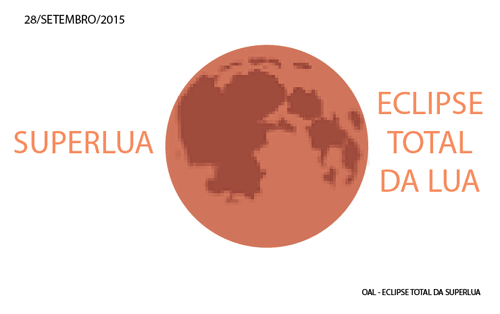| Science
In the early morning of September 28 the heavenly firmament will present one of the largest and most expected astronomical events of the year:. the occurrence of the third Super Moon of the year together with a Total Eclipse of the Moon
Esta is the night for the “astro-werewolves”. Well, maybe a new category a bit exaggerated but if we take into account the phenomenon that will be able to be seen in the Portuguese skies, this description fits perfectly.
An eclipse a Super Moon
The celestial spectacle this morning begins shortly after one in the morning, time to mainland Portugal.
Around 1h10min, the natural satellite of Earth, the moon enters the Earth’s penumbra and from this moment begins to darken acquiring gray tones.

Credit: Astronomical Observatory of Lisbon / University of Lisbon
Gradually the moon enters the Earth’s shadow and 2h07min begins to acquire more reddish and brownish tones.
To 2h46min. Day dawn 28, the moon will reach perigee of its orbit (which will be the shortest, 2015), in which the mileage registration will be 356,877 kilometers from Earth (about 49600 km closer than when in apogee ).
The last astronomical phenomenon identical to that tonight, in Portugal, there was 1982 and the next one will be in 2034
A difference that will make the moon appear 14 percent larger in the sky than when the full moon occurs at the height (Super Moon).
The total eclipse will occur by 3h11min, when the moon is completely inside the cone of the Earth’s shadow.
The natural star Earth will not disappear altogether seen this take on a reddish and brownish color, a faint light is the combination of the shadows of the two cones that hide the solar white light sun (see figure).
O eclipse will be visible with the same look in all the Earth places them at the time the moon above the horizon.
eclipse of Greatness = 1,276 considering the diameter of the moon as a unit.
Thus, people who have the opportunity to see this total eclipse of the moon will be those living in Portugal mainland and islands in Western Europe as well as in West Africa, South America and central and eastern North America.

Credits: Astronomical Observatory of Lisbon / University of Lisbon
In short, the progression of the eclipse in Portugal (time to continental Portugal) is as follows:
The Moon enters in the shadows to ……… .. …………………. 01:10
The moon enters the shadow to …………… .. ……………… .. 02:07
Middle of the eclipse at …………………………… …. ……. 03:47
The moon comes out of the shadow …………… .. ………………… 05:27
The moon leaves the penumbra to ………………. ……………. 06:24
A seen opportunity to excellence can only observe the same phenomenon in 2034!
NASA satellite studying Moon could shut down due to insufficient lighting
The astronomical phenomenon this morning means beauty and spectacle for some, terror to others but also of concern.
The Lunar Reconnaissance Orbiter (LRO), one of the most important probes NASA, whose primary mission is to explore and monitor the natural satellite of Earth may be at risk of being shut down because of the eclipse.
With the eclipse LRO will run out of direct sunlight for three hours
The operability of the probe depends almost exclusively from sunlight to keep active.
Tonight, because of the eclipse and occultation of sunlight by the Earth, LRO will be for a few hours without the main power source . needed to power computers and scientific instruments it carries on board
According to Noah Petro, NASA scientist the BBC: “Two things happen during an eclipse: the first is very cold and there is no light to charge batteries (the ship). And with the eclipse, a NASA spacecraft will run out of direct sunlight for about three hours. “
Despite this concern, this is not the first time the LRO Agency American space passes, successfully, by a lunar eclipse. Other three lunar eclipses occurred in the last 17 months.
While waiting for nearest news of the moon, scientists will at least be able to observe from Earth, the moon in the most beautiful astronomical phases that know the star natural land.


No comments:
Post a Comment